Cool weather is here to stay, and Korean radish, mu (무), is in season. A perfect combination for muguk (Korean radish soup)! You probably haven’t seen muguk served at restaurants, but it’s a staple soup in Korean homes. It’s an easy soup to make, but I’ll share some basics and tips which will be helpful.
Korean radish, mu (무), tastes best during late fall and winter. They are juicy and slightly sweet. Buy one that is firm and heavy.
I used a quick method that’s common in Korean cooking to make a beef soup base. See another method in my tteokguk (떡국) recipe. The thinly sliced beef is seasoned with Korean soup soy sauce and sautéed before being boiled in water. The result is a broth with deep flavors that deliciously complement the white radish.
This soup base can be used for different types of soups, such as tteokguk, gamjaguk, and miyeokguk. You can use napa cabbage instead of radish in this recipe for sogogi baechu guk.
More Soup Recipes
Watch how to make it
For more Korean cooking inspirations, follow along on YouTube, Pinterest, Twitter, Facebook, and Instagram.
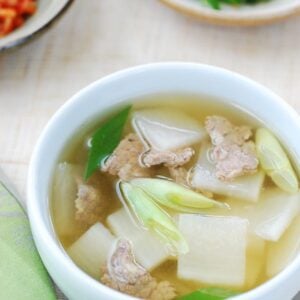
Ingredients
- 12 ounces Korean radish, mu, 무
- 2 scallions
- 6 ounces beef brisket, chuck, or loin
- 2 teaspoons minced garlic, divided
- 1 teaspoon sesame oil
- 2 tablespoons Korean soup soy sauce, guk ganjang, 국간장 (see note) See note
- salt and pepper to taste
Instructions
- Cut the beef into thin bite size pieces. Marinate with 1 tablespoon of soup soy sauce, 1 teaspoon of garlic, a pinch of pepper, and 1 teaspoon of sesame oil. Set aside.
- Cut the radish into bite size pieces (1 to 1.5-inch square, about 1/4-inch thick). Cut the scallions into 1 to 1.5-inch pieces.
- In a medium pot, sauté the beef until all the pieces turn brown. Pour in 8 cups of water and bring it to a boil. Skim off the foam. Reduce the heat to medium high and continue to boil, covered, for 10 minutes.
- Add the radish pieces and boil, covered, until the radish turns translucent and soft, 10 to 15 minutes. Stir in the remaining teaspoon of the garlic, scallions, and the remaining tablespoon of the soup soy sauce. The soup should not look too dark. Taste for salt and pepper. Boil for an additional 5 minutes.


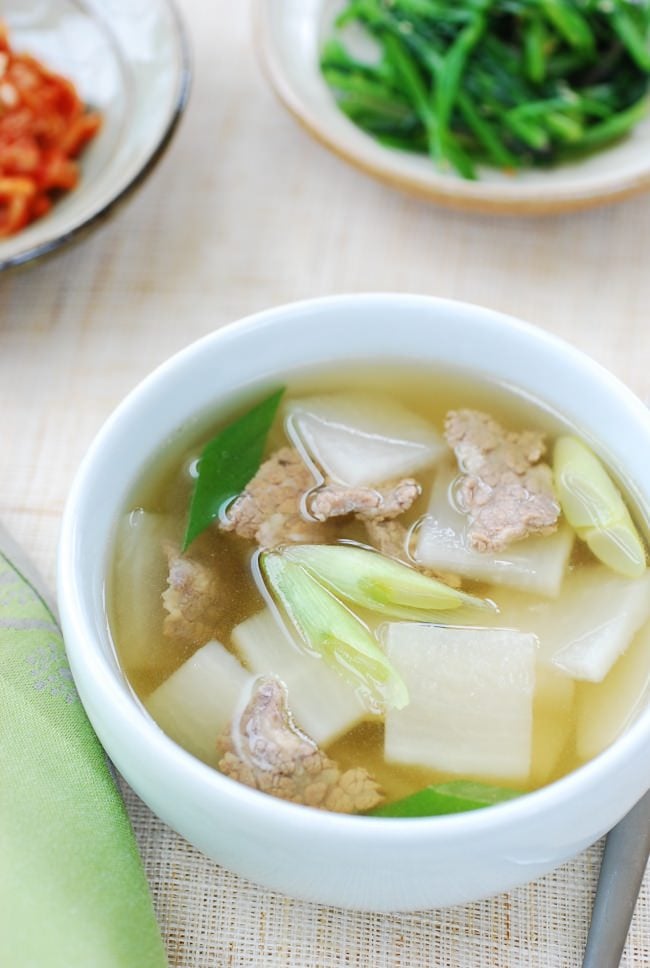
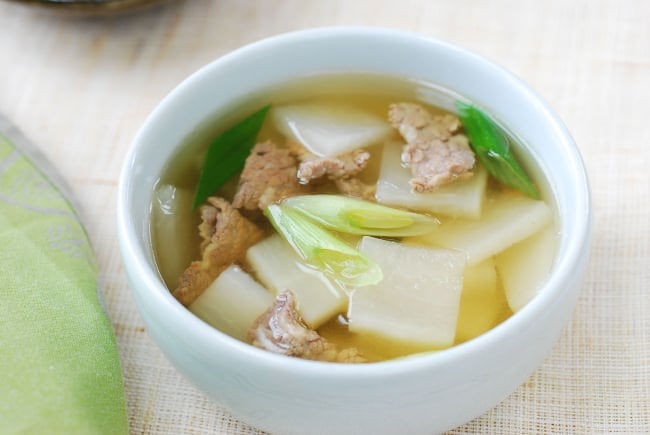
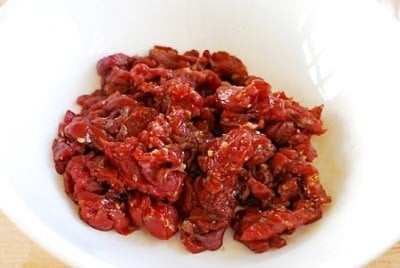
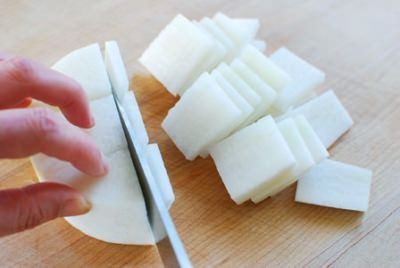
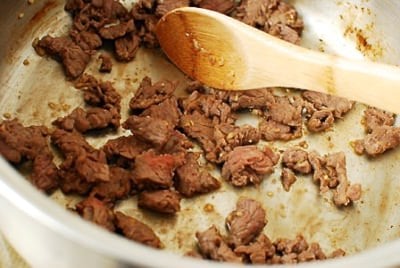
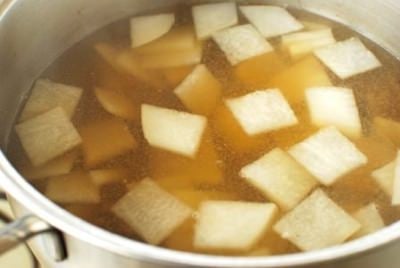
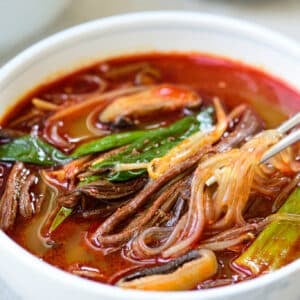
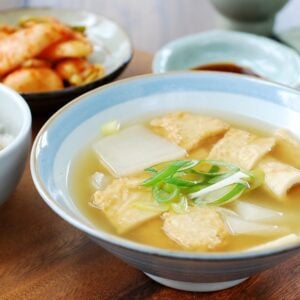
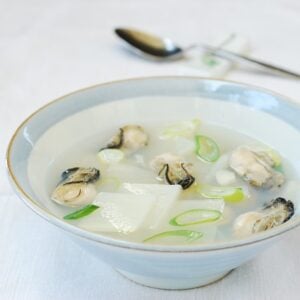
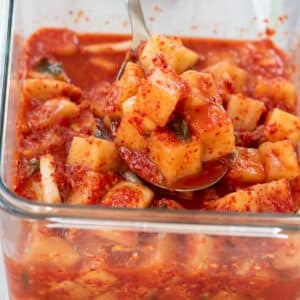













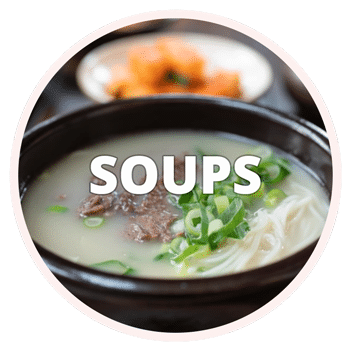
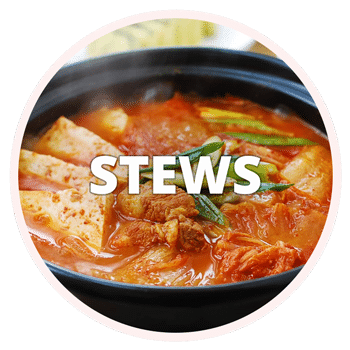


MJ says
This was delicious. I have made another muguk recipe before and this one tasted so much better. I think marinating the beef first makes such a big difference.
I used daikon and fish sauce as that was what was easily available where I live.
Thank you for the great recipe, will definitely be making it again!
Hyosun says
Great!! Thank you!
Patricia says
Can you add soy bean sprouts as well?
Jeremy says
Yes you can. If you want to, you can add korean dried chili flakes for a little spice and make it into another traditional Korean dish.
Nadine says
Hello,
i love this recipe. 🙂 Cooked it serveral times! So easy and delicious. Thanks for sharing.
Greetings from Germany 🙂
Hyosun says
Hello Germany! Great! Thank you for letting me know!
Julie says
Made this as stated and it was perfect! It was so good that I made it yesterday again and doubled the recipe because wanted some leftovers for this rainy weather. I added some napa cabbage the second time around just to have some more vegetables in the meal and it was great! Thanks so much for sharing these delicious and easy meals. Makes weekly meal planning so easy!
Wendy says
Hi Hyosun;Today is not so hot and I feel like something hot, so, for the umpteenth time I am going to make this delicious soup. We love. Kisses. Greetings from Spain and take good care of you
della says
I was only able to find purple Korean radish at my local store. Do you think it would work for muguk?
Tom says
This is of our family favorites. We use our garden grown radishes and harvested venison and make large batches of this wonderful soup and can for year round!
Trupti Patel says
I have made this recipe twice and both times I’ve added Gochujhang and chili peppers! It takes the soup to another level! But I love the base recipe! Thanks for making it so easy.
Sandra says
I made this soup with Sempio soup soy sauce (the one with the yellow label) and it came out really dark. I added two more cups of water and then some salt (not sure how much – just to taste). It became lighter, but still much darker than your pictures on this website. I have another soup soy sauce (the one pictured in your ingredients web page) and I will try that one next time.
Even though it was dark, it was delicious! It was a perfect lunch for my family – filling, yet “light”. Thank you!
OnaLisa says
I love that this recipe uses very little meat, comes out clean and full of umami flavor. I’ve tried different versions from different sites and hands down this is the BEST one. Though a humble dish, there’s a detail or two in this recipe that makes it perfect. This is a great soup for breakfast if you’re a traditional breakfast hater like myself. Egg, rice and radish soup. Yummm! All can be made ahead of time.
Mer says
I’ve been making this soup for about a month straight as easy Sunday meal prep for lunches at least for the first half of the week. It is absolutely wonderful, savory and healthy.
Hyosun says
Nice! I love to make soups on weekends and enjoy for a few week days as well. And this soup is one of my favorites! Thank you so much for using my recipe and for the feedback! Cheers!
Carrie says
Hello! I had a question. What happens if the soup looks too dark? Do you add more water? Thanks!
Hyosun says
Not unless if it’s too salty. It may be too dark if you used regular soy sauce, not soup soy sauce. Also, some soup soy sauce brands are dark. It’s not salty but you still want to make it lighter, you can add more water to dilute and add salt to season. Hope this helps!
Nana says
Like this sharing soegogi muguk menu for good, but I just used beef to corn beef and added some cayyean with mushroom. Because my family and friends like spicy food.
Lindsey says
My boyfriend was craving this soup but I was a little hesitant to make it because it has so few ingredients. Needless to say, I gave it shot and it was PERFECT! The broth is SO flavourful, you don’t need more veggies. The raddish is also very tender and has a great texture. I paired it with Dubu Jorim and Japchae, which all went well together. The savory quality of the soup balanced the intense spiciness of the Dubu. I used all the recipes from your website. You are a great cook and can translate ingredients and instructions well for English readers :). Thanks Hyosun for a fantastic site!
Juli Kim says
Hello thank you for sharing. Can i substitute pork instead of beef??
Hyosun says
Sure! I make some soup with pork. It’s delicious.
Fausto says
Great recipe and easy to follow, Loved the fast broth tip!
Thank you,
Hyosun says
My pleasure! Hope you find many more recipes you enjoy.
Sherrie Yokoro says
I made this soup for my mother-in-law, she loves it. The soup was really light and being elderly, she said having the soup and rice was enough for a quick dinner. Thank you for sharing this recipe with us.
Hyosun Ro says
Aww that’s so nice to hear! Thanks for letting me know.
Theresa says
Thanks so much for all your wonderful recipes. This soup is the one I make the most–so simple but delicious and healthy! My mother says I’m a better cook than she is–all thanks to you! My other favorites include mandu and the jjukkimi gui–spicy–grilled baby octopus–all perfectly seasoned. Thanks again for sharing all of your well-written and authentic recipes.
Anonymous says
my mom made this the other day but she used fish sauce in it instead soy sauce is it the same dish or is it something else just similar. she wont write any of her recipe down for me so I’m not sure if its the same thing?
Hyosun Ro says
It’s sounds like the same soup. Some people use fish sauce to season soups. Just matter of preference.
Anonymous says
Thank you so much for the recipe!!! Your website really makes making Korean food easier for someone like me who is missing the domestic gene…I made this twice already and even my husband enjoyed it 🙂 FYI I’m a horrible cook so for him to actually say that it was good is BIG 😀 I’m so happy I found your website!!!
Hyosun Ro says
Aww I’m so happy to hear that. And glad to be helpful. Keep on cooking! You’ll get better at it each time. Thanks for coming by! Happy cooking!
Charles Loving says
Thank you for all the beautiful and informative posts! I can’t wait to try these recipes.
I am hoping you can help me to understand better how to serve soup and stew at a typical Korean dinner. I am going to be hosting some Korean friends for dinner to celebrate Dongji in a couple of weeks. I plan to keep it simple as I am just starting out with Korean cooking and don’t have the skills yet. Just rice, soup (maybe Kongnamul guk or Mu guk), some sides (banchan) and maybe a stew. Your blog will be a real asset for me and I’m very glad I found you!
I have read several articles that seem to say each person receives an individual serving of rice and soup, and the other dishes are placed in the center to be shared. Would you be so kind as to review the logistics of serving a stew. How is it presented on the table? How is it actually dished up? It doesn’t appear that the individual place settings are set with an empty bowl, so I don’t really understand what to serve the stew into.
I know these may seem like dumb questions, but I have been searching to figure it out with no luck so far. I would love to serve one of your delicious stews such as gochujang jjigae, but struggling to know exactly what to do with it once I have made it. Thank you again.
Hyosun Ro says
Hi Charles – You’re right. In the case of soup, each person receives an individual serving along with a bowl of rice. The other dishes are served in the middle to be shared. We Koreans consider stews to be communal dishes, so usually a pot of stew is placed in the middle and shared. But, in more formal settings or when you have guests, it can be served individually like soup, or an empty bowl is provided for each person to take their portion. In your case, you are thinking of having both soup and stew, so each person would have two individually served bowls. That’s quite okay. I wouldn’t worry too much about these logistics. I’m sure your guests will enjoy the food regardless. Hope this helps. but let me know if you have any other questions. Cheers!
Sue says
Your blog is great. So far I’ve made the moo guk and the sun du bu and thought they were both very delicious and authentic. Your directions are very easy to follow. Thank you! I have two questions about this recipe, if you don’t mind. The beef came out kind of tough for me. Is there a way to make it more tender? Just simmer it longer? Also, I think you need to peel the radish, yes? Again, thank you!
Hyosun Ro says
Hi Sue – I’m glad to hear they turned out delicious. Cut beef thinner and simmer longer. Also, if you desire, you can use tenderer meat like rib eye or sirloin. No, you don’t need to peel radish as long as it’s clean. Hope this helps. Thank you for using my recipes. Cheers!
thewinegetter says
I made this dish for my wife the other day. I am a German living in Michigan now, but I spent six months in Seoul in 2000/2001 and since have been very fond of Korean cuisine. My wife (an Alaskan) was initially skeptical (a radish soup??), but I remembered it fondly from my time in Seoul.
It tasted amazing! Thank you so much for that recipe, and I am looking forward to trying many, many more! You made my day!!
정말 감사합니다!!
Oliver
Hyosun Ro says
Oliver – Thank you so much for trying out my recipe. I’m very happy to hear it turned out well for you. Hope your wife will fall in love with Korean food, and you guys can enjoy more and more together. Cheers!
Anonymous says
Thank you so much for this recipe. My family loves it!
Melia says
it came out just like my aunt’s soup. Thank you so much for posting this recipe. This will come in handy this winter. It is so delicious!!!!
Sauteed Radish says
It looks delicious and healthy.
Hyosun Ro says
Fern – Korean radish is a variety of daikon radish (aka white radish) and smaller and bulkier. It has a little different flavor and texture too. Korean radish, I think, is crunchier and juicier. You can use any daikon radish for this soup.
Fern @ To Food with Love says
I’m so tempted to try this soup because it looks really good! How is Korean radish different from regular daikon?
Hyosun Ro says
Alice – That is so sweet! I am totally flattered and appreciate your kind words. It’s very rewarding to hear from my readers that they cook Korean food at home using my recipes. I know I am very happy to hear from my kids about their Korean cooking, so I understand how your mom and grandma feel about yours. Keep up the good work!
Alice says
There’s a reason why I have you as one of my top bookmarks. From the photography to the easy to read and understand recipes, you’ve single-handedly inspired me to get in the kitchen and cook! I live in Miami, where there are practically no Korean restaurants, and because of this blog, I’ve recently started to recreate my favorite Korean food at home. My mom and halmoni (who live far away) are proud– I’ve been emailing and calling them with all my cooking updates. Looks like my transition to being an ajjuma is almost complete!
vincent says
Hello,
We bumped into your blog and we really liked it – great recipes YUM YUM.
We would like to add it to the Petitchef.com.
We would be delighted if you could add your blog to Petitchef so that our users can, as us,
enjoy your recipes.
Petitchef is a french based Cooking recipes Portal. Several hundred Blogs are already members
and benefit from their exposure on Petitchef.com.
To add your site to the Petitchef family you can use http://en.petitchef.com/?obj=front&action=site_ajout_form or just go to Petitchef.com and click on “Add your site”
Best regards,
Vincent
petitchef.com
Hyosun Ro says
Stella – I am not sure how long it’s been there, but it might be still okay to use. Radishes store well in the fridge. You can cut it up and see if the flesh is still juicy and firm. Hope this helps. Thanks for stopping by.
Stella says
Can anyone help me? I bought a Korean radish to make Kimchi but didn’t have the time that week. Now it is still sitting there… How long is it good for if I’m making this yummy soup? It still feels firm.
denise @ bread expectations says
I’m spending more and more time at Korean food marts and though I’m not familiar with like 80% of the stuff I see, it’s still fascinating! I think I’ll be browing your site more than usual – thanks for your always helpful and informative posts, this one being no exception 🙂
Hyosun Ro says
Looks great! I am sure it was delicious and comforting. Yours definitely looks pretty too. Good job!
invisaligngal says
Hi, I had a great excuse to make mu guk today because it has been raining like crazy in Los Angeles! Perfect soup for such a cold and wet day….mine probably doesn’t look as pretty as yours but if you have a chance you can look at the photo I posted on my Facebook page! It was delicious.
A little bit of everything says
This kind of radish you used is different from daikon or is the same thing?
thanks.
Hyosun Ro says
Korean radish is a variety of daikon radish (aka white radish). You can use any daikon radish for this soup.
Hyosun Ro says
Erica – Your Korean is very impressive! Hope you make the soup. Gukganjang makes a big difference.
Thanks for visiting.
Andrea – Thanks!
Judy – I don’t do that all the time. Sometimes he’s on his own. Then he makes ramen,instant that is, which is about only thing he makes.
Tammy – Try with potatoes. My mother used to make gogi guk with potatoes and tofu. She would also put in dangmyeon (starch noodles) at the end. It was delicious, and I make this version once in a while too. Thanks for stopping by.
Susan – Korean soup soy sauce does make a huge difference in Korean soup. It’s not expensive and you only need a little bit at a time. So it will last forever if you buy a bottle. Thanks for visiting.
Cook With Susan says
I love Korean beef soups and can eat them daily if given the opportunity. I didn’t know that there is a product such as Korean soup soy sauce? That ingredient would change my life (ha,ha). I hope I can find it at my local Asian grocer. I will be off to track one down today. Have a safe trip.
Tamar1973 says
I <3 Moo Guk but those large Korean radishes are hard to find where I live.
Judy says
I will need to look for Korean soup soy sauce when I go to the Korean market next time. My husband loves soup based with beef broth but I am usually very lazy and use canned beef broth. I’m sure he would appreciate this soup made with beef broth from scratch. Your husband is so lucky to have such a wonderful and kind wife. 🙂 I am guilty of leaving my husband to fend for himself if I am not home for dinner and there are no leftovers!
Andrea@WellnessNotes says
Have a good trip!
Your husband is very luck! 🙂 I love mu guk!
erica says
Oh, I’m so glad I picked up a bottle of 국간장 on my big trip to K-town yesterday–this looks like a great recipe to try! Thanks for posting, and have a good trip!